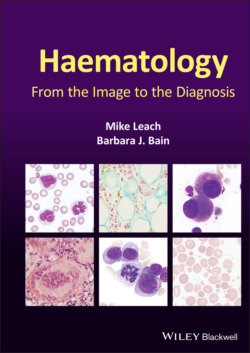Читать книгу Haematology - Barbara J. Bain, Irene Roberts - Страница 25
Оглавление16 Sickle cell anaemia in crisis
A 33‐year‐old woman with known sickle cell anaemia, newly arrived in the United Kingdom, presented to Accident and Emergency with a painful crisis. She was breathless, febrile and faintly jaundiced. Her FBC showed Hb 51 g/l, RBC 1.72 × 1012/l, Hct 0.165, MCV 95.8 fl, MCH 29.8 pg, MCHC 311 g/l, WBC 13.8 × 109/l and platelet count 445 × 109/l. Bilirubin was increased to 141 μmol/l and ALT was mildly increased to 55 u/l. CRP was markedly increased to 137 mg/l. Examination of the blood film (all images ×100 objective) showed boat‐shaped cells (top) but surprisingly infrequent sickle cells. There were some nucleated red blood cells and polychromasia was present. The changes of hyposplenism were present, specifically Howell–Jolly bodies (top), rare acanthocytes (top right), target cells (bottom left), giant platelets (bottom right) and thrombocytosis. An unusual feature was the presence of cells with haemoglobin condensed at the two poles of the cell and of irregularly contracted cells including hemighosts (top right and bottom left). An even more unusual feature was the presence of Plasmodium falciparum gametocytes (bottom right) and trophozoites (top). HPLC showed absent haemoglobin A, haemoglobin S 86.5% and haemoglobin F 5.1%.
Sickle cell trait protects from falciparum malaria but the converse is true of sickle cell anaemia, in which malaria can be life‐threatening. Opportunistic detection of malaria parasites in a patient in whom the diagnosis has not been suspected clinically can be life‐saving. Another warning sign in this patient is the presence of irregularly contracted cells and hemighosts. This observation correlates with the presence of hypoxia (Siow et al. 2017).
Reference
1 Siow W, Matthey F and Bain BJ (2017) The significance of irregularly contracted cells and hemighosts in sickle cell disease. Am J Hematol, 92, 966–967.
MCQ
1 Causes of worsening anaemia that would be likely in a 30‐year‐old African or Afro‐Caribbean woman with sickle cell anaemia include:Folic acid deficiencyHaemolytic crisisParvovirus B19 infectionSplenic infarctionSplenic sequestrationFor answers and discussion, see page 206.
